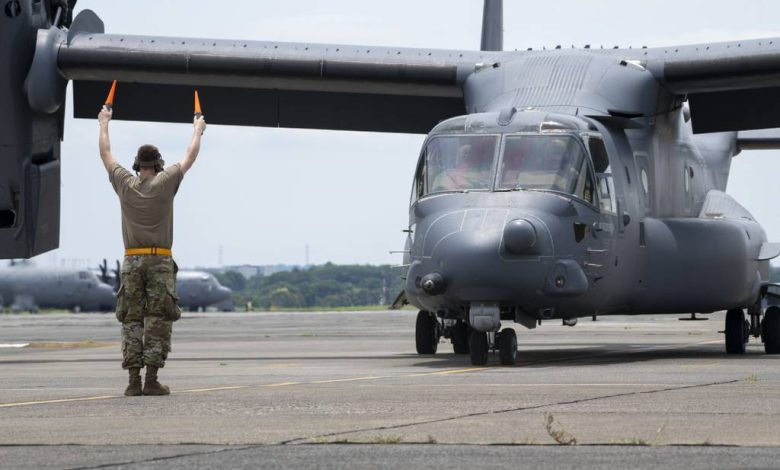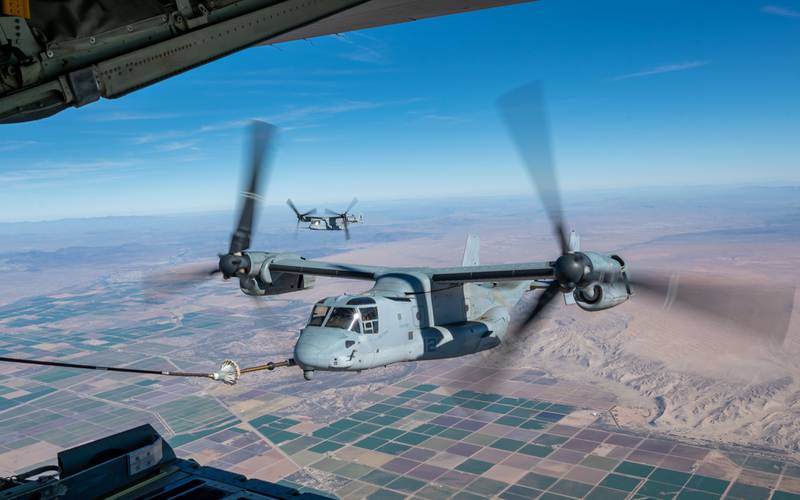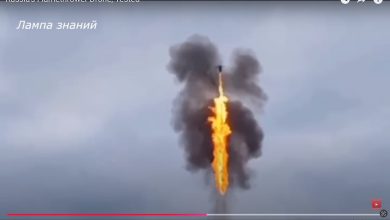Air Force Ospreys in Japan resume flight ops

U.S. Air Force crews from the Japan-based 353rd Special Operations Wing started flying the CV-22 Osprey once again Tuesday, seven months after one of the aircraft crashed during a training mission, killing all eight airmen on board.
The return to flying followed a “multi-phased” approach to ensure the readiness of crews and follows a “meticulous and data-driven approach” that includes the development of added safety controls, the Air Force said in a news release.
RELATED
“We remain steadfast in our commitment to ensuring the safety of the men and women who operate our aircraft and the safety of our community both on base and in Japan,” 21st Special Operations Squadron Commander Lt. Col. Matthew Davis said in a statement. “These safety mitigation measures have been taken seriously, and we would not fly this aircraft without full confidence in the measures, the maintenance professionals implementing them, and the skilled professionals who fly it.”
The U.S. military has said it doesn’t expect its fleet of more than 400 tiltrotor Osprey aircraft to return to full flying operations until at least mid-2025. Naval Air Systems Command, which leads the joint program office overseeing the aircraft, began allowing the Osprey to fly again in March after a three-month grounding was lifted but with added restrictions.
Ospreys can be flown like an airplane and take off and land like a helicopter. Its vertical take offs and landings make it useful for carrier landings as well as for special operators operating in austere environments. The controversial aircraft has suffered a string of fatal crashes since being introduced into special operations more than two decades ago with four mishaps responsible for the deaths of 20 service members in the last two years.
RELATED

The military grounded the Ospreys in 2022 and again in 2023, after a series of “hard clutch engagements” that occurred when the input quill assembly, which attaches the Osprey’s engine to its proprotor gear box, wore out earlier than expected. A redesigned clutch is expected to begin testing with fielding anticipated mid-2025. Testing is also underway on a vibration sensing system upgrade to identify complements that need to replaced and a proprotor gearbox pinion bearing redesign is awaiting production and installation.
The military has said the Nov. 29 crash of GUNDAM 22 was the result of a material failure that hadn’t been seen before on the Osprey. An investigation into that crash is nearing completion.
The Marine Corps, which operates hundreds of the aircraft, used them in Sweden as part of Exercise Baltic Operations with the 24th Marine Expeditionary Unit, which last week conducted flight operations with the Osprey from the amphibious assault ship USS Wasp in the Mediterranean Sea. The Navy, which owns about 30 of the aircraft, is sidelined from using them in its carrier support mission and remains barred from flying them more than 30 minutes from an airfield where they could land in an emergency.
The Air Force owns about 50 Ospreys. While the 353rd resumes flying, crews from the 27th Special Operations Wing, based at Cannon Air Force Base, New Mexico, have also resumed limited flying operations based on aircraft availability after spending months keeping up their proficiency in simulator training, something Japan-based crews have also done while preparing to return to the air. That includes putting pilots and flight engineers through a specific return-to-flight simulator syllabus, Capt. Paul Danielson, a flight commander and Osprey pilot with the Cannon-based 20th Special Operations Squadron, told Air Force Times.
Cannon-based maintainers continued sustainment necessary on the CV-22s during the stand down and were trained on maintenance protocols directed by NAVAIR to return to fly, 20th Special Operations Maintenance Squadron Commander Maj. Shelby Olivera said, adding that they’re also completing rigorous inspections. Squadrons are progressing through those protocols based on aircraft maintenance needs and personnel experience levels, she said.
As the 20th Special Operations Squadron focuses on reaching basic proficiency, the unit is first focusing on getting flight instructors back in the air. Pilots and maintainers look are looking forward to getting Ospreys flying once again, Danielson and Olivera said.
“The morale of the squadron, I think, has gone up just seeing people fly,” Danielson said. “There’s also a good balance of understanding from the the crews that aren’t flying, understanding that the leadership is doing what is best just ensure safety moving forward.”
Courtney Mabeus-Brown is the senior reporter at Air Force Times. She is an award-winning journalist who previously covered the military for Navy Times and The Virginian-Pilot in Norfolk, Va., where she first set foot on an aircraft carrier. Her work has also appeared in The New York Times, The Washington Post, Foreign Policy and more.







